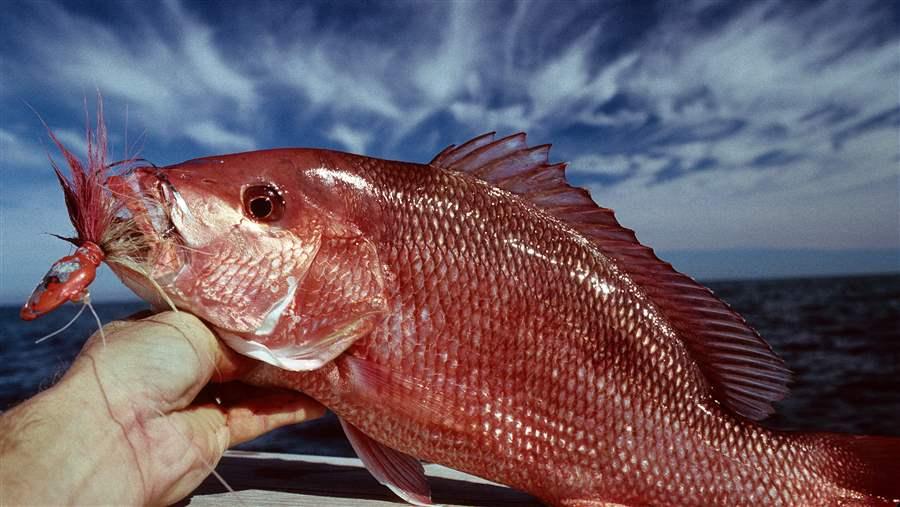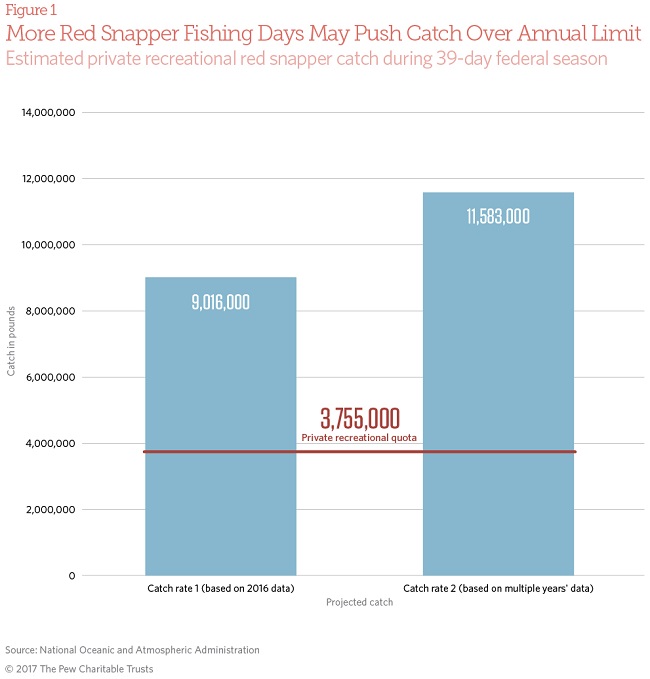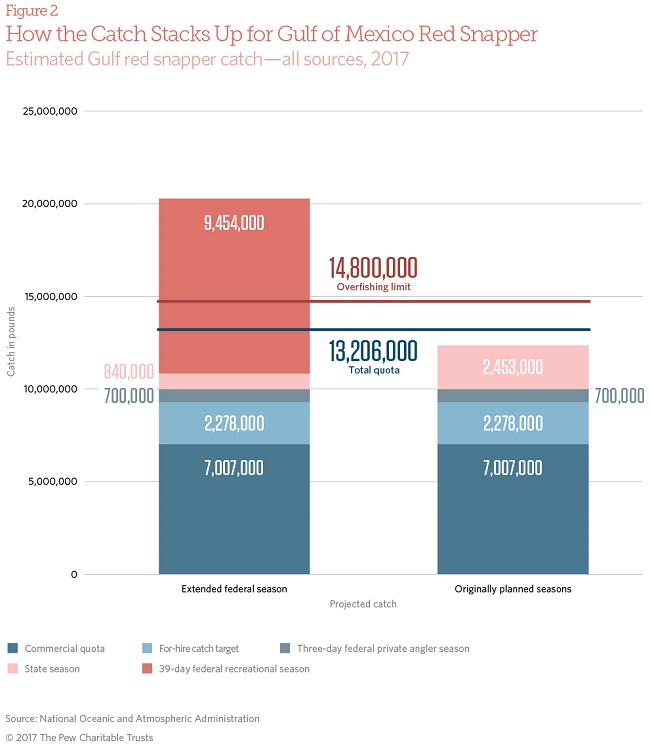Overfishing of Gulf Red Snapper Likely After Feds Extend Season
Action could spell trouble for species that is recovering
A federal decision to extend the fishing season for Gulf of Mexico red snapper this summer is likely to lead to overfishing and could allow private recreational anglers to take up to three times as much fish as they are legally allowed under scientifically sound catch limits, according to an analysis of fishery data by The Pew Charitable Trusts.
Pew analyzed estimated red snapper catch rates and projections from the National Oceanic and Atmospheric Administration’s Fisheries Service and, in addition to the finding above, concluded that the total 2017 landings in the Gulf by all fishermen will probably exceed legally allowed amounts by at least 37 percent.
That’s a disturbing scenario for a species that plummeted to low population levels from overfishing in the 1990s. Gulf red snapper have been recovering thanks to federally mandated, science-based catch limits and court-ordered measures to prevent catching the fish faster than they can reproduce, but that progress is now in jeopardy.
The U.S. Department of Commerce’s June decision to extend the private recreational season by 39 days ignores those science-based quotas, puts the health of the species at risk, and—according to the announcement—delays red snapper’s full recovery by as much as six years, from 2032 to 2038. The department made the decision without releasing data or scientific analysis, and with no opportunity for public input.
Before that extension, private recreational anglers—those who fish from privately owned boats rather than hiring a charter or head boat captain—had a catch limit of about 3.8 million pounds of red snapper for 2017. Pew found that the added fishing days could yield an additional 9 million to 11.6 million pounds of catch (Figure 1)—about three times higher than the science-based catch limit for private anglers.
That would push the red snapper catch by all fishermen to around 20 million to 22 million pounds (Figure 2), well above the 14.8 million-pound limit that scientific advisers to the Gulf of Mexico Fishery Management Council recommend to prevent overfishing, which occurs when catch is too high to allow the population to replenish itself.
An overfishing designation is significant because it requires managers to implement restrictions to halt overfishing within two years and affects all fishermen, including the charter and commercial fleets.
Behind the numbers: How experts projected the 2017 catch
NOAA Fisheries forecasted that commercial, charter, and party boat captains would catch their combined 2017 quota of almost 10 million pounds because those groups have in recent years caught most of their limits. Based on estimated catch rates from previous years, the agency also projected that recreational anglers would catch about 2.5 million pounds of red snapper in state waters and another 700,000 pounds in federal waters.
That disparity is due to increasingly long state fishing seasons and the annual response by NOAA Fisheries to shorten federal seasons to help prevent overfishing. (State waters extend 9 miles off the coast; the federal zone starts there and runs to 200 miles offshore.) This year the original state seasons were scheduled to range from 67 days in Alabama to 365 days in Texas. That’s why the agency set the 2017 federal season for recreational anglers at only three days.
The total of all red snapper fishing for 2017—in state and federal waters combined—was projected to be 12.4 million pounds, which is 17 percent below the overfishing limit. But the addition of the 39 days in federal waters for private recreational anglers makes those estimates moot. Pew estimates that the catch from state waters was about 840,000 pounds as of mid-June, with more fishing to come. The states initially agreed to stop their seasons on June 15 in exchange for the added federal days, but now Texas, at least, is planning to allow fishing from Labor Day to the end of 2017. All of these factors combined are likely to lead to significant overfishing this year.
Consequences of going over the limit
Judging from recent history, the 2017 catch could be even higher than predicted. In eight of the past 10 years, private recreational anglers as a group exceeded their quota by as much as several million pounds.
When the recreational quota is exceeded for overfished populations such as red snapper, that overage is supposed to be subtracted from the next year’s catch limit, leading to shorter federal seasons intended to allow the population a chance to rebound and keep full recovery on track. Those paybacks are another reason that the 2017 federal season for red snapper was so short. As rules stand now, overages still require paybacks, but it’s unclear whether that will apply next year.
That’s because the rule applies only to overfished species. The Gulf of Mexico Fishery Management Council, which governs Gulf fishing in federal waters, has changed the rules for determining when red snapper and other reef fish reach unhealthy levels and should be declared overfished. Under the new rules, fish populations would have to drop to much lower levels before federal fishery law would require fishery managers to act.
This is a highly risky move that allows significant overfishing this year on a recovering population. And it could jeopardize the long-term health of all reef species, which are adjusting to changing ocean conditions, including warming and more frequent episodes of harmful environmental phenomena such as red tides.
Waiting to act until populations reach very low levels may force fishery managers to drastically lower catch limits in future years for longer periods to put those species on the road to recovery.
NOAA Fisheries is slated to issue a new red snapper population assessment next spring, but as of now that assessment won’t include data from the 2017 fishing season—or what is likely to be substantial overfishing this year. Ignoring those data could further hamper red snapper’s recovery. The government’s assessment should account for what’s happening this season.
If policymakers don’t let science guide the rules, they risk the health of this iconic species—and other natural resources that must be protected for future generations.
Holly Binns directs The Pew Charitable Trusts’ efforts to protect ocean life in the Gulf of Mexico, the U.S. South Atlantic Ocean, and the U.S. Caribbean.












